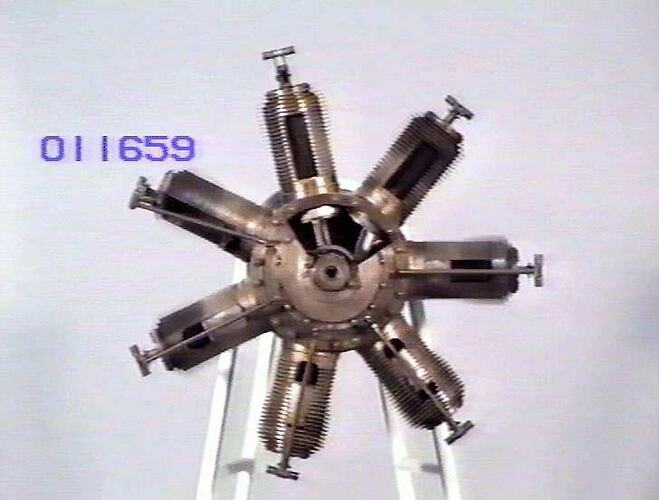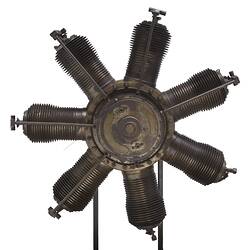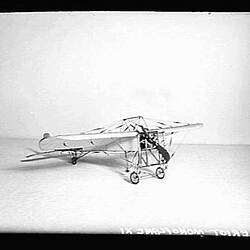Summary
The Gnome rotary aero engine was made by the Societe Des Moteurs Gnome & Rhone in Paris. It was the most successful early aero engine design. The journal 'Flight' stated in its 31 December 1910 edition that "...it not only worked satisfactorily but was at one time practically the only motor capable of developing the necessary power within the necessary limits of weight".The rotary engine operated on the principle of a fixed crankshaft with the cylinders revolving at high speed. Gnome & Le Rhone engines were developed to include an 80 horsepower (9-cylinder), 100 horsepower, (14-cylinder) and a 160 horsepower models. Gnome engines were built under licence in Britain, Italy and the United States. Various models of the Gnome rotary were fitted to types including the Avro 504 trainer, the Sopwith Pup and the French Nieuport 28C.1 fighter aircraft. Rotary engines had a good power-to-weight ratio but there were limitations to their development as increasing gyroscopic forces in the direction of the spinning cylinders caused handling problems. The oil system was a 'total loss' principle which sprayed castor oil not only on the engine but also over the pilot if the engine was mounted at the front. There was no throttle control with engine speed regulated by a 'blip switch' operated by the pilot which could cut the ignition temporarily. By 1918 the rotary was considered obsolete for military aviation.
This 50 horsepower, 7-cylinder Gnome engine, Serial No. (1743) 4937 was purchased by the Museum at an auction of six surplus aircraft and five aero engines plus spare parts held at Point Cook, Victoria on 19 March 1919 by Charles Forrester & Co. on behalf of the Defence Department. The purchase price was £40 for the only Gnome engine sold on the day. A note on file states that this engine had been imported some five years previously which would indicate it was part of the original batch of equipment purchased for the Australian Flying Corps at the time the Central Flying School (CFS), Point Cook was established in 1914. The British & Colonial Aeroplane Co. (Bristol) were the British empire agent for Gnome engines. This type of 50 horsepower, seven-cylinder Gnome Omega rotary engine was installed in the Bristol Boxkite aircraft used at the School for flying training. In 1915 a spare 50 horsepower Gnome engine was also fitted to Boxkite CFS.8 manufactured at Point Cook, the first military aircraft to be built in Australia. The Gnome engine was also used for ground instruction of trainee mechanics at CFS. Following acquisition, the engine was sectioned for the Museum at a cost of £450 to show its internal components.
More Information
-
Collecting Areas
-
Acquisition Information
Purchase
-
Maker
-
Place & Date Used
Central Flying School, Point Cook, Greater Melbourne, Victoria, Australia, circa 1914-1919
One of 6 aeroplanes and nine aero engines sold at public auction by Charles Forrester & Co on the Defence Department's behalf. This was the only Gnome engine sold at that time. -
Classification
Air transport, Aero engines, Reciprocating propeller engines
-
Category
-
Discipline
-
Type of item
-
Overall Dimensions
70 kg (Weight)
Weight estimate by curator - excluding stand.
-
References
See SMV correspondence file 378/1, or details of puchase and cost of sectioning.
-
Keywords


